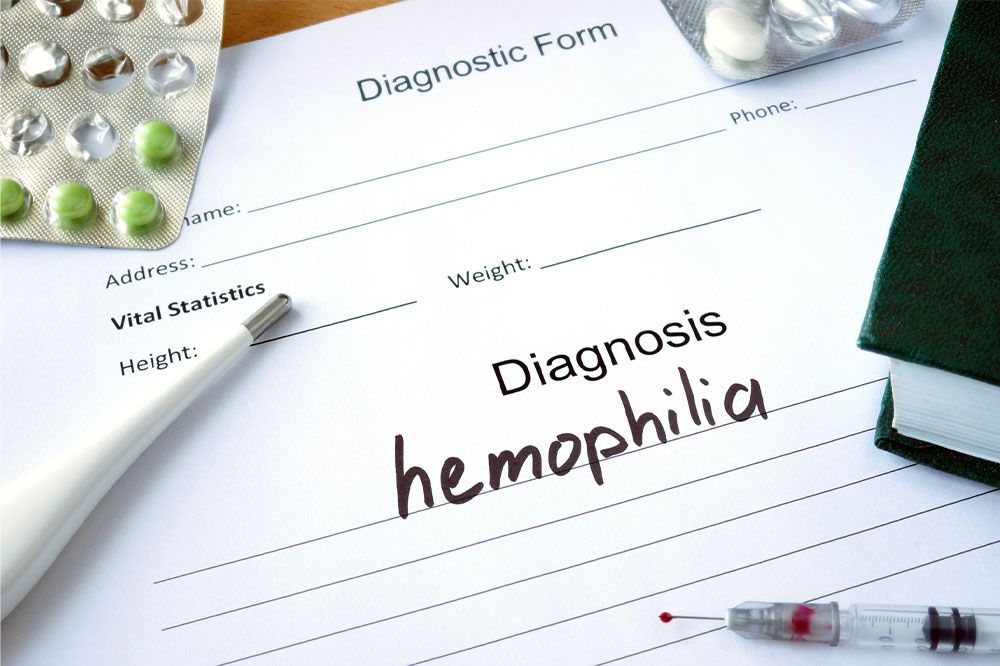Hemophilia – Its types, symptoms, and management

Hemophilia is a group of congenital or acquired bleeding disorders where the blood takes time to clot. People with this disorder may bleed longer if they have an injury or surgery. According to the CDC, about 30,000 to 32,000 people in the country suffer from hemophilia. Contrary to popular belief, this is treatable if the condition is diagnosed and treated on time. Other important facts and information about hemophilia are as follows:
What is hemophilia?
A clotting factor is a protein in our blood that controls bleeding. If our blood does not have adequate quantities of this protein, it takes time for the blood to clot. Normally, in the case of any injury, trauma, or surgery, bleeding stops right after first aid, dressing, or once the doctors suture the site. However, in a person with hemophilia, the bleeding may continue for a long time and may need attention and treatment. The clotting factors that affect blood clotting are VIII, IX, and XI. Hemophilia is classified based on which clotting factor is lacking in the affected person.
Types of hemophilia
The type of hemophilia a person has is based on what clotting factors their body lacks. There are three types of hemophilia. They are Hemophilia A, B, and C. While Hemophilia A is more common, types B and C are rare.
- Hemophilia A
Hemophilia A or classic hemophilia happens when a mutation in the F8 gene results in lower production of clotting factor VIII or FVIII. It is predominantly an inherited condition. FVIII is found in the X chromosome, and as a result, it affects men more than women. - Hemophilia B
If a person has none or insufficient blood clotting factor IX, or FIX, the condition is hemophilia B and is also referred to as Christmas disease. It occurs when there is a mutation in the gene f9, which is found in the X chromosome. As a result, men are at a higher risk than women. - Hemophilia C
If a person has low blood clotting factor XI or FXI, the condition is classified as Hemophilia C. It is also known as Rosenthal Syndrome. FXI is found in the F11 gene located on chromosome 4. Men and women inherit two copies of chromosome 4, and both are at risk if they inherit a defective gene. Though hemophilia C is predominantly inherited, autoimmune diseases like lupus can also cause it.
Three forms of hemophilia A, B, and C
The three forms of hemophilia A, B, and C are mild, moderate, and severe. The form never changes till the end. A person with a moderate or severe form of hemophilia will remain so forever. However, if a person has a mild form of type A, their bodies could produce more FVIII as they age.
Symptoms
Hemophilia A and B
The symptoms of type A and B are very similar. Severe hemophilia can be diagnosed early within the first year of a child’s birth. Doctors monitor infants closely if anyone in the family has a history of hemophilia. Babies may develop bruises and unusual swelling after birth or sometimes within one year. They may also have excessive bruising after immunization. As they grow and begin to play, they may bruise easily, even with slight knocks or falls. Boys may bleed longer after circumcision or tooth extraction. Other symptoms of hemophilia A and B in adults include:
- Pain and swelling in joints and muscles
- Easy bruising
- Frequent nosebleeds
- Bloody urine
- Long hours of bleeding after tooth extraction or a heel prick
Hemophilia C
The symptoms in type C are generally milder, and there is a lesser risk of internal or spontaneous bleeding.
Diagnosis of hemophilia
Doctors physically examine the patient and check for bruises or any unusual bleeding. They also prescribe blood tests to check the activity levels of clotting factors. Using the blood tests, doctors will also classify if the person has mild, moderate, or severe Hemophilia A, B, or C.
Treatment and management of hemophilia
- Hemophilia A and Hemophilia B
Doctors regularly inject FVIII or FVIII intravenously or directly into the bloodstream. Doctors may also administer FVIII or FIX as a preventive measure for those with severe Hemophilia A or B. - Hemophilia C
Doctors administer antifibrinolytics to slow down the breakdown of fibrin. They may also administer frozen plasma or concentrated FXI.
For all types of hemophilia, doctors may administer the clotting factors regularly or when bleeding happens. Apart from administering clotting factors, other processes and therapies that are used to treat hemophilia are:
- Hormone therapies
Doctors use hormone therapies for mild forms of hemophilia. They inject the hormone through a vein or a nasal spray, simulating the production of the relevant clotting factor. - Prescriptions
There are some newer approaches to treat hemophilia A, using prescriptions by doctors that prevent bleeding. Doctors also use antifibrinolytics to prevent the breaking down of clots. - Fibrin sealants
Fibrin sealants are surgical formulations applied to injury sites to aid clotting and healing. - Physical therapy
Physical therapy can help relieve pain caused by bleeding in joints and muscles.
Hemophilia is a treatable condition when diagnosed and treated on time. It is essential to speak to a doctor if one notices any of the above-mentioned symptoms.









